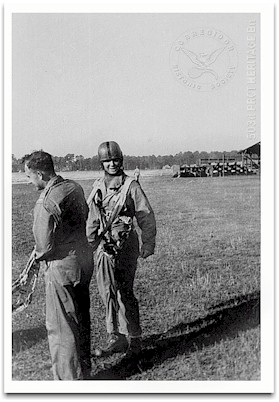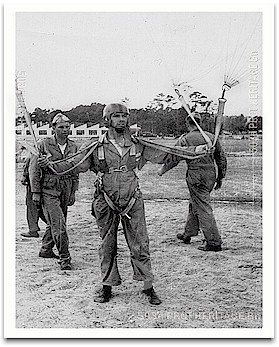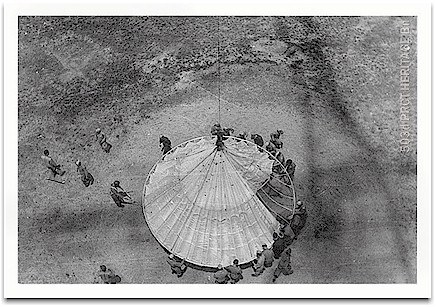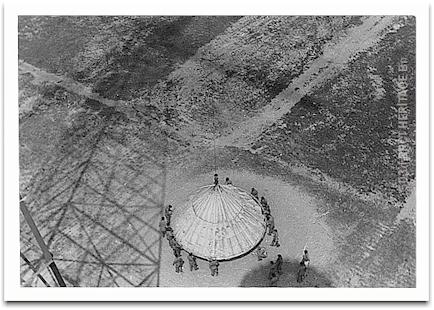|
Was it the third week
when things got a bit easier? This was when we were introduced to the
steel jump towers. Actually, they were fun.
Parachutes were held
open by clips attached to wires running from
earth to the top of the tower. You stood under the chute in your harness and
were hauled 200 feet into the air. At the top the chute was released and you
floated back to earth, guided by the vertical wires. That was the easy part.
The tough part was what I called the no-chute test. You lay on your belly on
the ground in your parachute harness. The harness was attached to a cable at
your back. There was no chute. At a signal you were pulled 150-feet into the
air, still horizontal. There you hung until an instructor with a megaphone
yelled up, "Pull!" At which command you pulled the rip cord at your chest
and you began to fall. The harness tightened after 15 feet and you were once
again vertical, jerking up and down like a rag doll. Then you were lowered
to the ground and another student took your place. The purpose of all this
testing of body and mind, I later realized, was to weed out those of us who
would not or could not endure it.
The fourth and final week was the easiest of all. All you had to do was make
five parachute jumps from a couple of thousand feet from a plane flying over
a field. If you balked or got badly hurt you were out. By this time some of
us had already been dismissed. You jumped one at a time, a tough sergeant
standing behind you to make sure you went out the door as ordered. You
didn't have to do anything, just jump. A 40-foot static line running from a
wire in the plane to the back of your harness pulled out the chute from its
pack as it broke away. But it was both fun and exciting and at the end you
got your wings and were a qualified paratrooper, ready for assignment to a
fighting unit.
I don't know where most of my fellow graduates went, but Guy Campbell and I
were sent to the 503rd Parachute Infantry Regiment at Fort Bragg, North
Carolina. We were ordered to report to the commander of Headquarters Co.,
Battalion, for assignment. After a few questions the captain realized we had
practically no experience in combat units. He assigned Guy to the light
machine gun platoon and me to the 81mm mortar platoon. Because the army
expected a high casualty rate for paratroopers, each platoon had two
officers. My leader was a Lieutenant Fickle (Fickel?), a man I soon came to
like and respect.
A mortar is a cumbersome weapon, consisting of a steel tube through which to
fire the shells, a bipod to support the top end and hold the sighting
mechanism, and a heavy steel base plate to hold the bottom of the tube. Each
part is heavy and awkward to carry, the base plate especially. We learned
that the hard way, because we carried our four mortars with us on every
march and tactical exercise.
I grew fond of those mortars. Awkward and heavy they might be, but they
could throw a seven pound shell almost 3,000 yards, flying high over any
obstacles and exploding effectively on impact. They were simple to use and
had no moving parts to break down. All you had to do was set the sight for
distance and aim and drop a shell down the tube. Then you made adjustments
to cover your target. That's an oversimplification, of course, but it's
basically what we did.
When we went on a tactical exercise, the mortars were disassembled and
rolled into heavy fabric bundles, along with the ammunition. Each bundle had
its own parachute. In flight we stacked two bundles in the open doors of
each of our planes, pushed them out at the drop point and jumped after them.
That was the fun part. Most training hours were spent in marches, dry firing
exercises, platoon tactics, and the like. One day the whole first battalion
stripped to shorts and shoes, ran two miles to a lake for a brief swim, and
ran back to barracks.
This went on week after week. And then we began to wonder how long it would
last and when we would be shipped out to a theater of war. With that came
the realization that I might lose my intended if I was gone for long. So, I
wrote to Mary and asked her to come down to Fayetteville and marry me. She
must have had similar fears, because she wrote with the same idea and our
letters crossed in the mail. I managed to rent the ground floor of a small
house in the town and arranged for the wedding to be held in the Episcopal
Church on August 8, 1942. Meanwhile, I visited regimental headquarters,
talked my way by a stuffy staff officer, and invited the colonel to attend.
I also invited a few of my buddies. Both sets of parents, plus my two
brothers, arrived in time to witness the ceremony. That was followed by a
small, very brief party. And we were married. The following morning I
hoisted Mary over my shoulder and went out on the front porch to greet our
families. Just hours later, they were gone, on their way back to
Massachusetts, and married life began. Mary couldn't cook very well, but we
had a lot of Charlotte Russe, which she could cook. And once in a while, we
would be joined for dinner by a friend from the regiment. Meanwhile, our
training went on. But not for long. Somewhere near the middle of October we
got orders to ship out and the regiment assembled at the nearby railroad
track, where we said goodbye to friends and family, and boarded the train
for a long, long trip to San Francisco.
Most thought we would end up in Europe. If not, why did they issue us long
underwear? The train was slow and all window shades had to be pulled. It was
boring, boring, but I did learn to play redeye and lost a few dollars in the
process. In about seven days we arrived in San Francisco and were taken to a
nearby camp. I don't remember how long we were there, perhaps a night or
two, and then were driven to the harbor, where we boarded a Dutch freighter,
the Poelau Laut, which would be our home for the next 44 days. |









